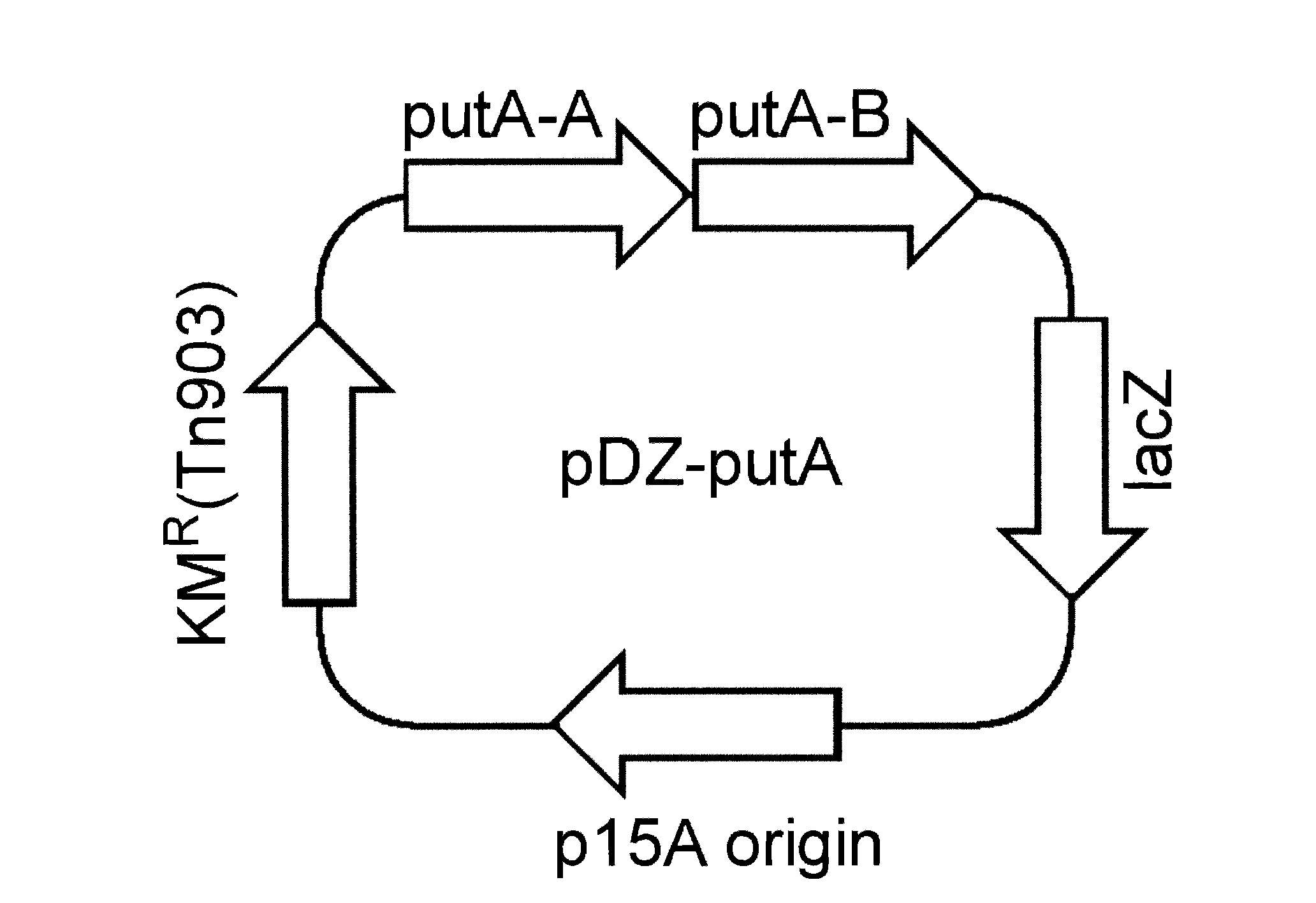Microorganism with improved production of 5'-xanthosine monophosphate and 5'-guanine monophosphate, and production method of 5'-xanthosine monophosphate and 5'-guanine monophosphate using same
a technology of guanine monophosphate and microorganisms, which is applied in the field of microorganisms with improved production of 5'-xanthosine monophosphate and 5'-guanine monophosphate, can solve the problems of limited material supply, low yield, economic non-benefit, etc., and achieve the effect of increasing the activity of proline dehydrogenas
- Summary
- Abstract
- Description
- Claims
- Application Information
AI Technical Summary
Benefits of technology
Problems solved by technology
Method used
Image
Examples
example 1
Cloning of the XMP-Producing Strain Corynebacterium ammoniagenes KCCM10530-Derived putA and Construction of Recombinant Vector (pDZ-putA) for Genomic Incorporation
[0040]In this Example, a pDZ vector disclosed in Korean Patent Publication No. 10-2007-94433 was used to perform genomic incorporation of the gene. For incorporation of the gene into Corynebacterium genome using the pDZ vector, a pDZ vector comprising the insert sequence at both ends was constructed, because a sequence having homology with a region incorporated into the chromosome must be comprised in the pDZ vector.
[0041]In this Example, for amplification of the putA gene, the nucleotide sequence of the putA gene (NCBI ID—3344496) was obtained based on the NIH GenBank. Based on the sequence, two pairs of primers (SEQ ID NOs. 1 to 4) were synthesized.
[0042]PCR was performed in the presence of the high-fidelity DNA polymerase PfuUltra™ (Stratagene, USA) using the genome of Corynebacterium KCCM10530 as a template and the oli...
example 2
Generation of putA-Inserted Strain
[0045]The pDZ-putA vector construct was transformed into the KCCM10530 strain and subjected to secondary homologous recombination with the genome to insert one copy of putA gene at a position adjacent to the putA gene on the genome, as described in Example 1. Thus, a XMP-producing Corynebacterium ammoniagenes KCJ-1346, which had two copies of the putA gene on the genome thereof, was obtained. The novel microorganism, designated as KCJ-1346, was deposited with accession number KCCM11068P at an International Depository Authority, the Korean Culture Center of Microorganisms (KCCM, 361-221, Yurim B / D, Hongie-1-dong, Seodaemun-gu, Seoul, Korea) on Feb. 24, 2010. The insertion of two copies of the putA gene in tandem was identified using PCR using a set of primers (SEQ ID NOs. 5 and 6) which targeted nucleotide sequences upstream and downstream of the two copies of the putA gene.
[0046]
SEQ ID NO. 5:CGAACTACGTGGCACAGTTTGSEQ ID NO. 6:AGCAGGCCATTAAAACGACC
example 3
XMP Production of the putA-Inserted Strain
[0047]The XMP-producing strain Corynebacterium ammoniagenes KCJ-1346 prepared in Example 2 was cultured to produce XMP as follows. The mother strain Corynebacterium ammoniagenes KCCM10530 and the strain KCJ-1346 were inoculated into respective 14 mL tubes, each containing 3 mL of the following seed medium, and incubated at 30° C. for 20 hours with shaking at 200 rpm. Then, the seed cultures were added in an amount of 0.4 mL to 32 mL of the following production medium (24 mL of main medium+8 mL of additional medium) in respective 250 mL corner-baffle flasks, followed by shake culturing at 30° C. and 230 rpm for 96 hours. Thereafter, the production of 5′-xanthosine monophosphate was quantitatively measured using HPLC. The XMP amounts produced from Corynebacterium ammoniagenes KCCM10530 and KCJ-1346 are given in Table 1, below.
[0048]
TABLE 1StrainKCCM10530KCJ-1346(g / L)28.629.9
[0049]Seed Medium: glucose 30 g / L, peptone 15 g / L, yeast extract 15 g / ...
PUM
| Property | Measurement | Unit |
|---|---|---|
| OD | aaaaa | aaaaa |
| pH | aaaaa | aaaaa |
| permeability | aaaaa | aaaaa |
Abstract
Description
Claims
Application Information
 Login to View More
Login to View More - R&D
- Intellectual Property
- Life Sciences
- Materials
- Tech Scout
- Unparalleled Data Quality
- Higher Quality Content
- 60% Fewer Hallucinations
Browse by: Latest US Patents, China's latest patents, Technical Efficacy Thesaurus, Application Domain, Technology Topic, Popular Technical Reports.
© 2025 PatSnap. All rights reserved.Legal|Privacy policy|Modern Slavery Act Transparency Statement|Sitemap|About US| Contact US: help@patsnap.com


